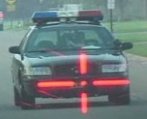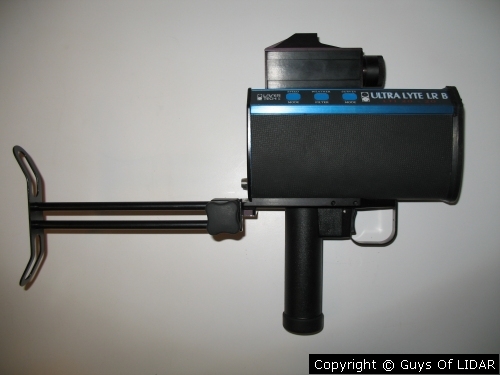


|
LTI Ultralyte

Right Side





Company Website: http://www.lasertech.com Specifications Speed Range: 0 to 200 mph (0-320 kph) Speed Accuracy: +/- 1 mph (+/- 2 kph) Target Range (speed mode): 50' to 2000' (Standard), 50' to 3280' (LR) Pulse Rates: Ultralyte 100/200 Standard (Non-LR) - 100 pps Ultralyte 100/200 LR Rev 1 (Serial number prefix "UL") - 100 pps Ultralyte 100/200 LR Rev 2, LR B, Compact (Serial number prefix "UX") - 125 pps Jam Codes E7 = JAM (Along with JAM indicator on the display, and a distinct audible tone to indicate jamming). It is rare to see E07. In all of the GOL jammer tests, this code has never been displayed. The only known jammers that trigger E07 are the older Lidatek LE-10 and Target LE-850, which are no longer produced. Newer jammers currently on the market do not trigger an E07, with the possible exception of "DriveSmart" products. False alerts are rare, but sometimes bright sunlight can trigger an E07. Notes The Ultralyte was introduced in 1997, and was "designed to reduce the size, weight, and manfacturing cost" of the guns. The longer range "LR" versions were introduced in 1998. There are many different variations of Ultralytes. Most of these are basically the same from a countermeasures perspective (except for the 100pps version, see below):
Laser Technology Inc was the very first company to introduce a police laser gun, which was their LTI 20-20 in 1991. Laser Technology Inc holds many patents on laser speed measurement technology, which they have licensed to all of the other laser gun manufacturers in the US. LTI laser guns are considered by some to be the technical standard by which all other laser guns are measured. 100 pps Ultralytes 
100 pps Ultralyte In some countries, the 100 pps Ultralytes present a unique challenge for the jammers. An overseas laser gun called the Jenoptik LaserPatrol also operates at 100 pps. This gun is generally used in areas where jammers are illegal, so preventing jam codes on the LaserPatrol is a priority for the jammers. Jammers identify the laser guns by the pulse rate, and then use a jamming algorithm customized for that specific laser gun in order to optimize jamming, and prevent triggering jam codes. Unfortunately, the jammers are unable to tell the difference between the 100 pps Ultralyte and the Jenoptik LaserPatrol, and must use the same algorithm for jamming both. Reportedly, it is a challenge for jammer manufacturers to design an algorithm which can both jam the Ultralyte effectively, and jam the Jenoptik without triggering jam codes. |
||||||||||
HOME | Tests & Reviews | FAQ | Technical Info | Articles | Videos | Links
About GOL | Contact Us | Terms of Use | Site Map